Legal Position and Remedies in Contract Law
VerifiedAdded on 2023/03/30
|10
|2374
|318
AI Summary
This article discusses the legal position and remedies available in contract law, focusing on a case study. It covers the essential elements of a contract, the legal position of each party, and alternative dispute resolution methods.
Contribute Materials
Your contribution can guide someone’s learning journey. Share your
documents today.
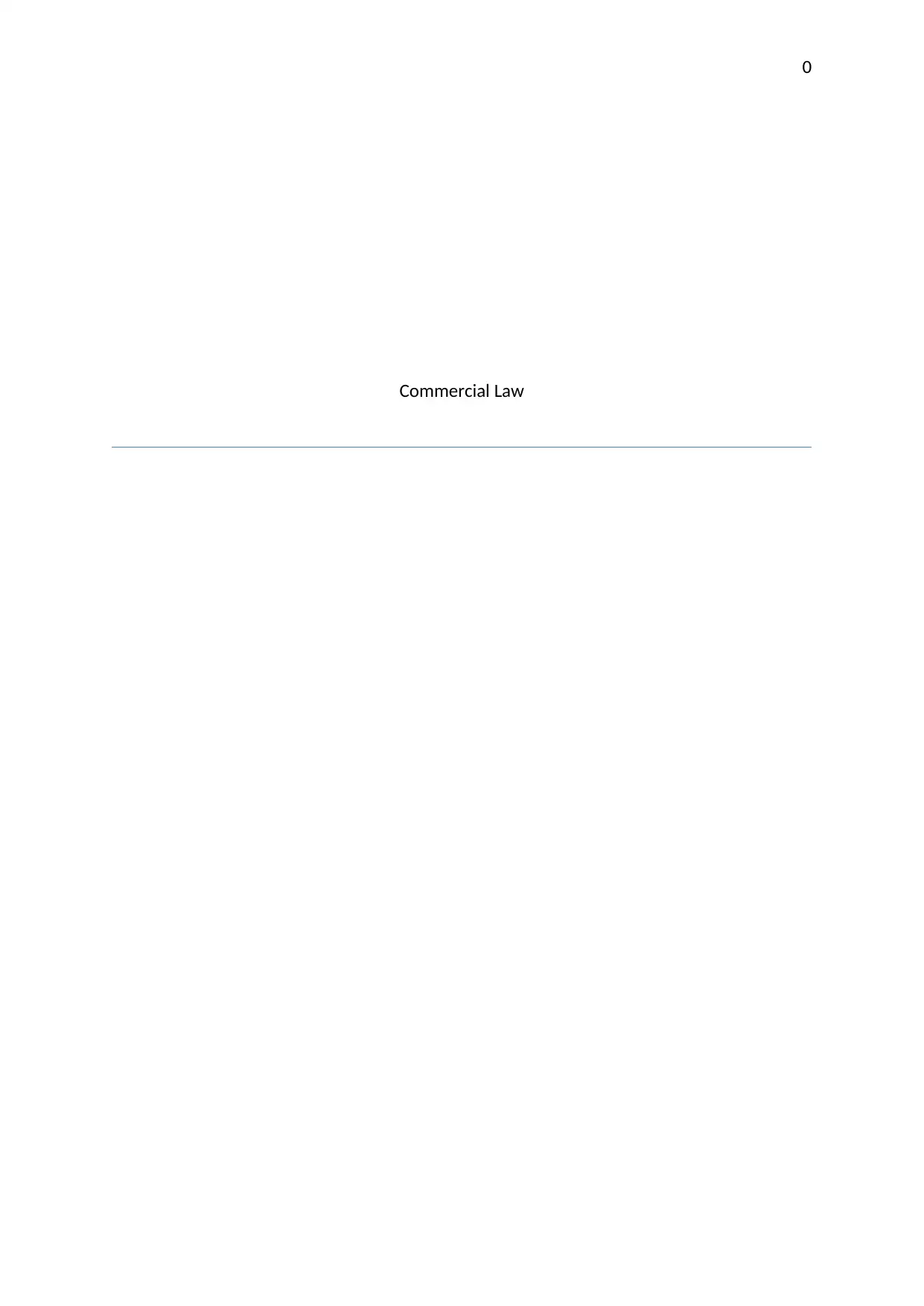
0
Commercial Law
Commercial Law
Secure Best Marks with AI Grader
Need help grading? Try our AI Grader for instant feedback on your assignments.
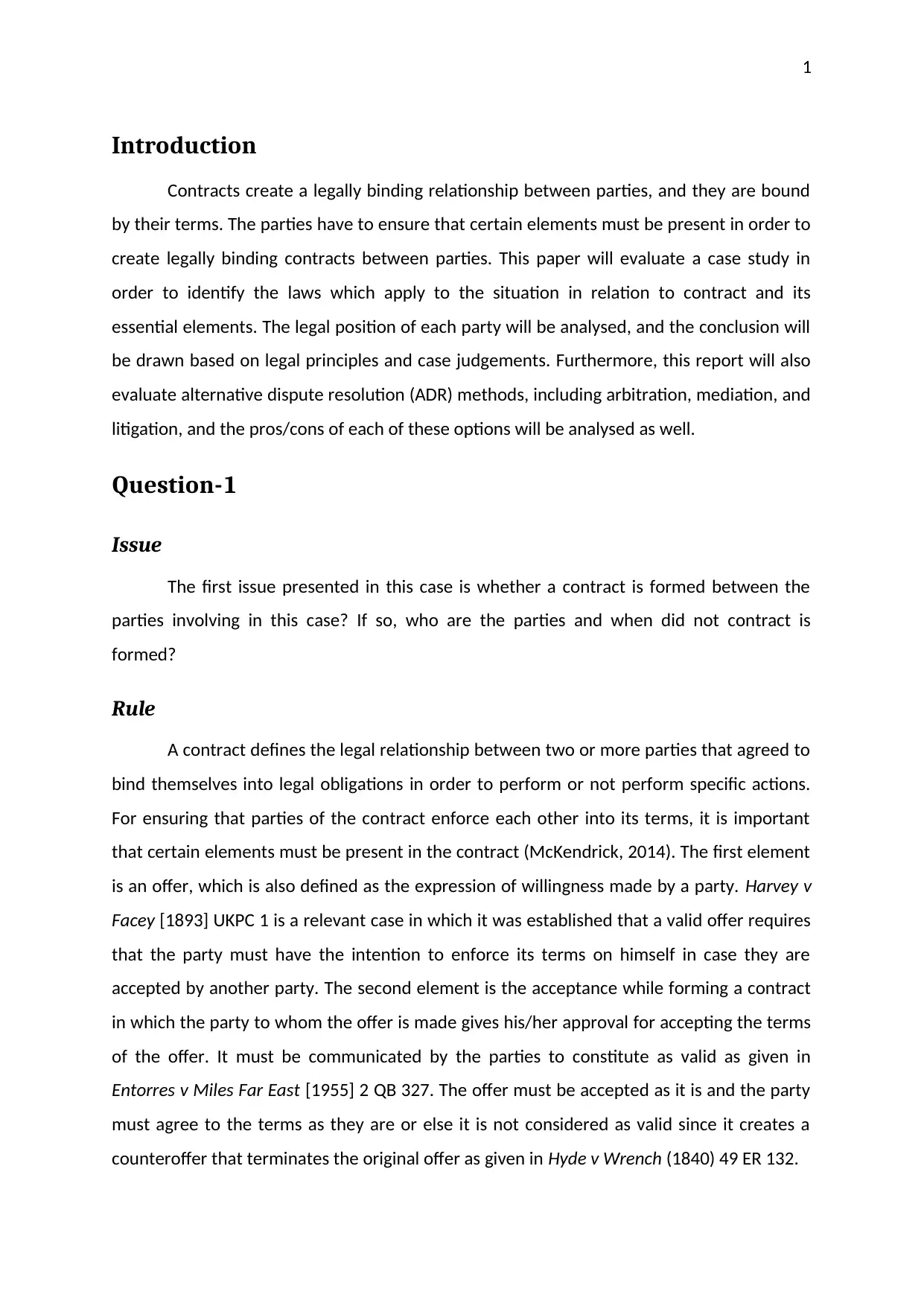
1
Introduction
Contracts create a legally binding relationship between parties, and they are bound
by their terms. The parties have to ensure that certain elements must be present in order to
create legally binding contracts between parties. This paper will evaluate a case study in
order to identify the laws which apply to the situation in relation to contract and its
essential elements. The legal position of each party will be analysed, and the conclusion will
be drawn based on legal principles and case judgements. Furthermore, this report will also
evaluate alternative dispute resolution (ADR) methods, including arbitration, mediation, and
litigation, and the pros/cons of each of these options will be analysed as well.
Question-1
Issue
The first issue presented in this case is whether a contract is formed between the
parties involving in this case? If so, who are the parties and when did not contract is
formed?
Rule
A contract defines the legal relationship between two or more parties that agreed to
bind themselves into legal obligations in order to perform or not perform specific actions.
For ensuring that parties of the contract enforce each other into its terms, it is important
that certain elements must be present in the contract (McKendrick, 2014). The first element
is an offer, which is also defined as the expression of willingness made by a party. Harvey v
Facey [1893] UKPC 1 is a relevant case in which it was established that a valid offer requires
that the party must have the intention to enforce its terms on himself in case they are
accepted by another party. The second element is the acceptance while forming a contract
in which the party to whom the offer is made gives his/her approval for accepting the terms
of the offer. It must be communicated by the parties to constitute as valid as given in
Entorres v Miles Far East [1955] 2 QB 327. The offer must be accepted as it is and the party
must agree to the terms as they are or else it is not considered as valid since it creates a
counteroffer that terminates the original offer as given in Hyde v Wrench (1840) 49 ER 132.
Introduction
Contracts create a legally binding relationship between parties, and they are bound
by their terms. The parties have to ensure that certain elements must be present in order to
create legally binding contracts between parties. This paper will evaluate a case study in
order to identify the laws which apply to the situation in relation to contract and its
essential elements. The legal position of each party will be analysed, and the conclusion will
be drawn based on legal principles and case judgements. Furthermore, this report will also
evaluate alternative dispute resolution (ADR) methods, including arbitration, mediation, and
litigation, and the pros/cons of each of these options will be analysed as well.
Question-1
Issue
The first issue presented in this case is whether a contract is formed between the
parties involving in this case? If so, who are the parties and when did not contract is
formed?
Rule
A contract defines the legal relationship between two or more parties that agreed to
bind themselves into legal obligations in order to perform or not perform specific actions.
For ensuring that parties of the contract enforce each other into its terms, it is important
that certain elements must be present in the contract (McKendrick, 2014). The first element
is an offer, which is also defined as the expression of willingness made by a party. Harvey v
Facey [1893] UKPC 1 is a relevant case in which it was established that a valid offer requires
that the party must have the intention to enforce its terms on himself in case they are
accepted by another party. The second element is the acceptance while forming a contract
in which the party to whom the offer is made gives his/her approval for accepting the terms
of the offer. It must be communicated by the parties to constitute as valid as given in
Entorres v Miles Far East [1955] 2 QB 327. The offer must be accepted as it is and the party
must agree to the terms as they are or else it is not considered as valid since it creates a
counteroffer that terminates the original offer as given in Hyde v Wrench (1840) 49 ER 132.
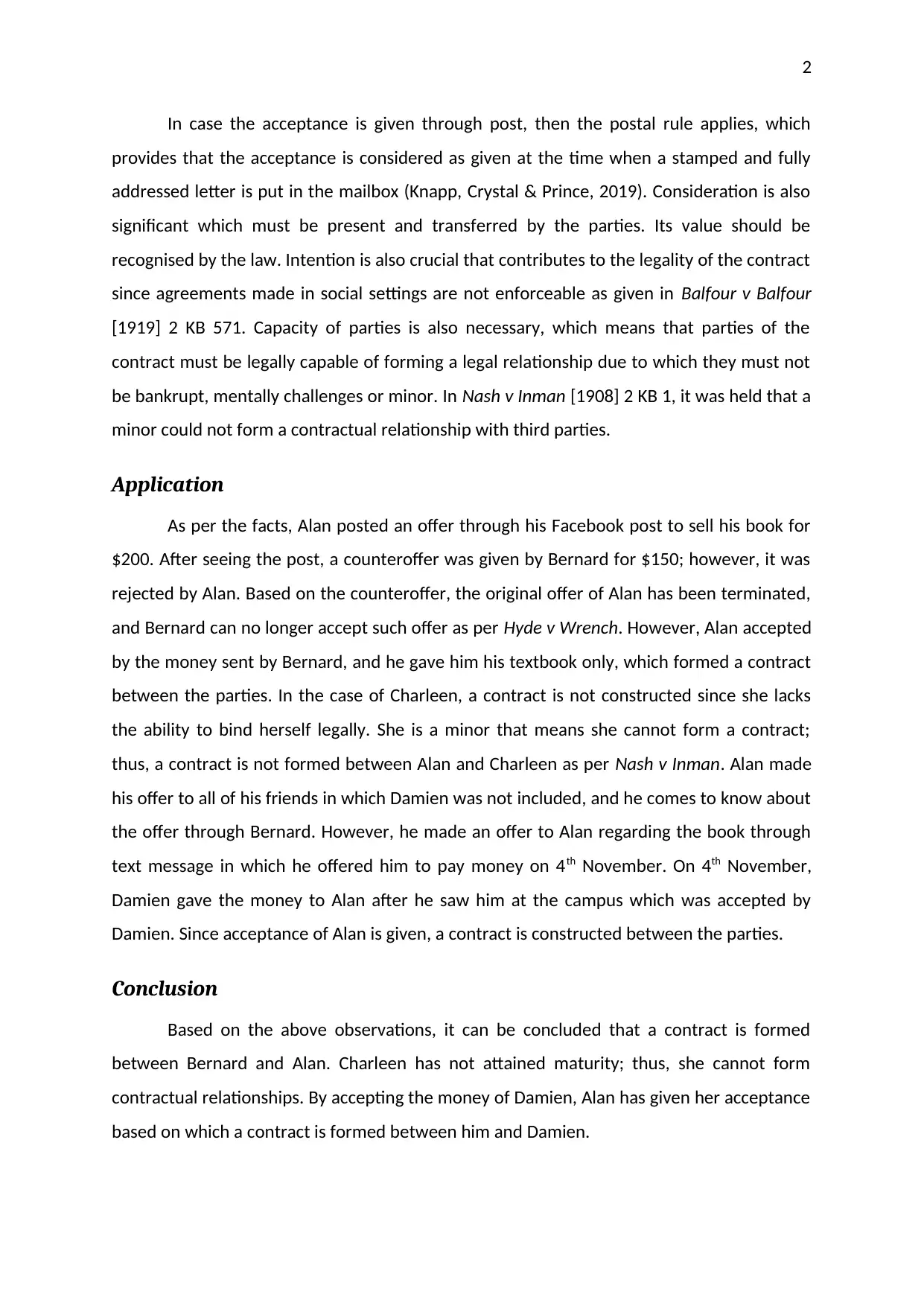
2
In case the acceptance is given through post, then the postal rule applies, which
provides that the acceptance is considered as given at the time when a stamped and fully
addressed letter is put in the mailbox (Knapp, Crystal & Prince, 2019). Consideration is also
significant which must be present and transferred by the parties. Its value should be
recognised by the law. Intention is also crucial that contributes to the legality of the contract
since agreements made in social settings are not enforceable as given in Balfour v Balfour
[1919] 2 KB 571. Capacity of parties is also necessary, which means that parties of the
contract must be legally capable of forming a legal relationship due to which they must not
be bankrupt, mentally challenges or minor. In Nash v Inman [1908] 2 KB 1, it was held that a
minor could not form a contractual relationship with third parties.
Application
As per the facts, Alan posted an offer through his Facebook post to sell his book for
$200. After seeing the post, a counteroffer was given by Bernard for $150; however, it was
rejected by Alan. Based on the counteroffer, the original offer of Alan has been terminated,
and Bernard can no longer accept such offer as per Hyde v Wrench. However, Alan accepted
by the money sent by Bernard, and he gave him his textbook only, which formed a contract
between the parties. In the case of Charleen, a contract is not constructed since she lacks
the ability to bind herself legally. She is a minor that means she cannot form a contract;
thus, a contract is not formed between Alan and Charleen as per Nash v Inman. Alan made
his offer to all of his friends in which Damien was not included, and he comes to know about
the offer through Bernard. However, he made an offer to Alan regarding the book through
text message in which he offered him to pay money on 4th November. On 4th November,
Damien gave the money to Alan after he saw him at the campus which was accepted by
Damien. Since acceptance of Alan is given, a contract is constructed between the parties.
Conclusion
Based on the above observations, it can be concluded that a contract is formed
between Bernard and Alan. Charleen has not attained maturity; thus, she cannot form
contractual relationships. By accepting the money of Damien, Alan has given her acceptance
based on which a contract is formed between him and Damien.
In case the acceptance is given through post, then the postal rule applies, which
provides that the acceptance is considered as given at the time when a stamped and fully
addressed letter is put in the mailbox (Knapp, Crystal & Prince, 2019). Consideration is also
significant which must be present and transferred by the parties. Its value should be
recognised by the law. Intention is also crucial that contributes to the legality of the contract
since agreements made in social settings are not enforceable as given in Balfour v Balfour
[1919] 2 KB 571. Capacity of parties is also necessary, which means that parties of the
contract must be legally capable of forming a legal relationship due to which they must not
be bankrupt, mentally challenges or minor. In Nash v Inman [1908] 2 KB 1, it was held that a
minor could not form a contractual relationship with third parties.
Application
As per the facts, Alan posted an offer through his Facebook post to sell his book for
$200. After seeing the post, a counteroffer was given by Bernard for $150; however, it was
rejected by Alan. Based on the counteroffer, the original offer of Alan has been terminated,
and Bernard can no longer accept such offer as per Hyde v Wrench. However, Alan accepted
by the money sent by Bernard, and he gave him his textbook only, which formed a contract
between the parties. In the case of Charleen, a contract is not constructed since she lacks
the ability to bind herself legally. She is a minor that means she cannot form a contract;
thus, a contract is not formed between Alan and Charleen as per Nash v Inman. Alan made
his offer to all of his friends in which Damien was not included, and he comes to know about
the offer through Bernard. However, he made an offer to Alan regarding the book through
text message in which he offered him to pay money on 4th November. On 4th November,
Damien gave the money to Alan after he saw him at the campus which was accepted by
Damien. Since acceptance of Alan is given, a contract is constructed between the parties.
Conclusion
Based on the above observations, it can be concluded that a contract is formed
between Bernard and Alan. Charleen has not attained maturity; thus, she cannot form
contractual relationships. By accepting the money of Damien, Alan has given her acceptance
based on which a contract is formed between him and Damien.
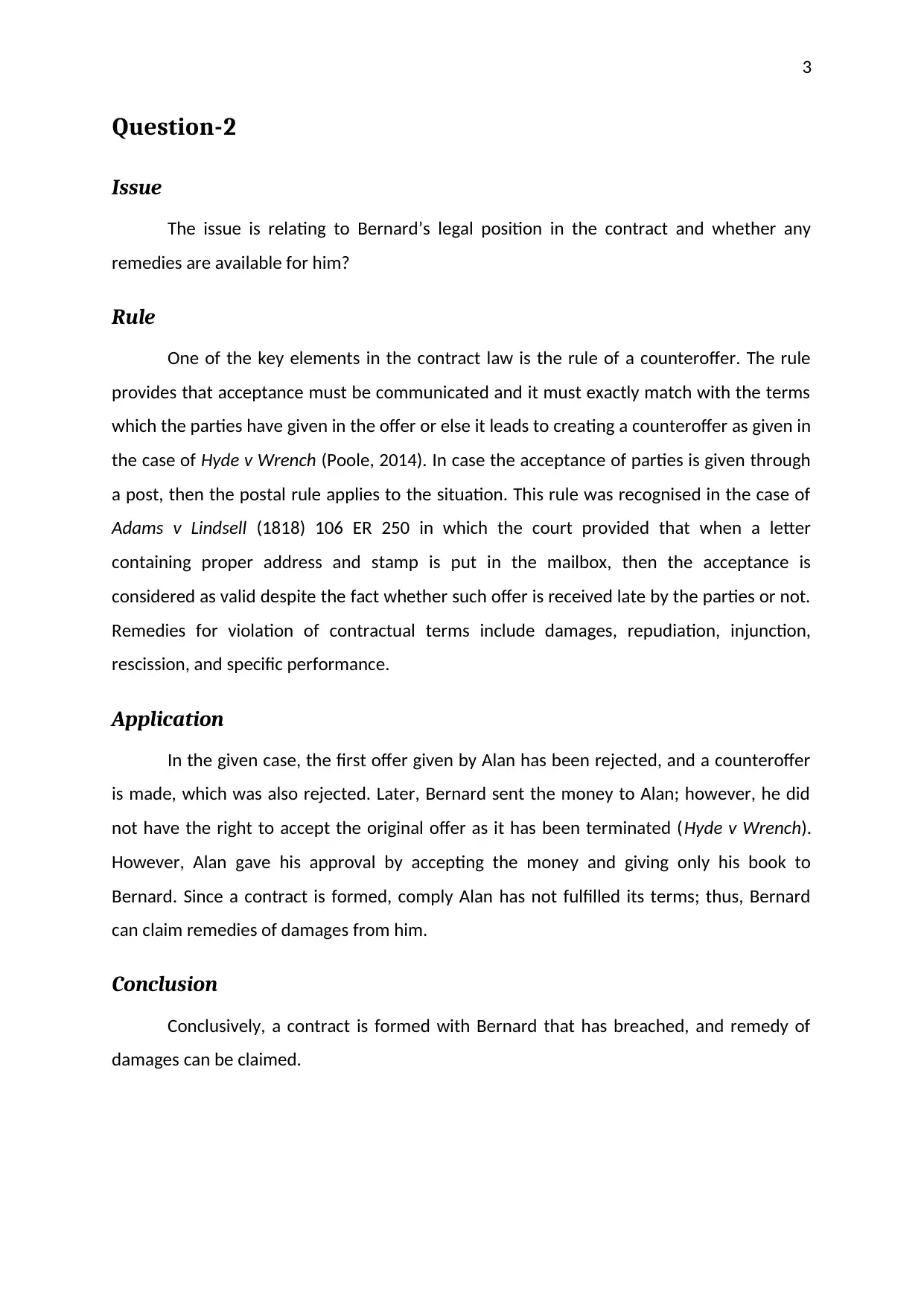
3
Question-2
Issue
The issue is relating to Bernard’s legal position in the contract and whether any
remedies are available for him?
Rule
One of the key elements in the contract law is the rule of a counteroffer. The rule
provides that acceptance must be communicated and it must exactly match with the terms
which the parties have given in the offer or else it leads to creating a counteroffer as given in
the case of Hyde v Wrench (Poole, 2014). In case the acceptance of parties is given through
a post, then the postal rule applies to the situation. This rule was recognised in the case of
Adams v Lindsell (1818) 106 ER 250 in which the court provided that when a letter
containing proper address and stamp is put in the mailbox, then the acceptance is
considered as valid despite the fact whether such offer is received late by the parties or not.
Remedies for violation of contractual terms include damages, repudiation, injunction,
rescission, and specific performance.
Application
In the given case, the first offer given by Alan has been rejected, and a counteroffer
is made, which was also rejected. Later, Bernard sent the money to Alan; however, he did
not have the right to accept the original offer as it has been terminated (Hyde v Wrench).
However, Alan gave his approval by accepting the money and giving only his book to
Bernard. Since a contract is formed, comply Alan has not fulfilled its terms; thus, Bernard
can claim remedies of damages from him.
Conclusion
Conclusively, a contract is formed with Bernard that has breached, and remedy of
damages can be claimed.
Question-2
Issue
The issue is relating to Bernard’s legal position in the contract and whether any
remedies are available for him?
Rule
One of the key elements in the contract law is the rule of a counteroffer. The rule
provides that acceptance must be communicated and it must exactly match with the terms
which the parties have given in the offer or else it leads to creating a counteroffer as given in
the case of Hyde v Wrench (Poole, 2014). In case the acceptance of parties is given through
a post, then the postal rule applies to the situation. This rule was recognised in the case of
Adams v Lindsell (1818) 106 ER 250 in which the court provided that when a letter
containing proper address and stamp is put in the mailbox, then the acceptance is
considered as valid despite the fact whether such offer is received late by the parties or not.
Remedies for violation of contractual terms include damages, repudiation, injunction,
rescission, and specific performance.
Application
In the given case, the first offer given by Alan has been rejected, and a counteroffer
is made, which was also rejected. Later, Bernard sent the money to Alan; however, he did
not have the right to accept the original offer as it has been terminated (Hyde v Wrench).
However, Alan gave his approval by accepting the money and giving only his book to
Bernard. Since a contract is formed, comply Alan has not fulfilled its terms; thus, Bernard
can claim remedies of damages from him.
Conclusion
Conclusively, a contract is formed with Bernard that has breached, and remedy of
damages can be claimed.
Secure Best Marks with AI Grader
Need help grading? Try our AI Grader for instant feedback on your assignments.
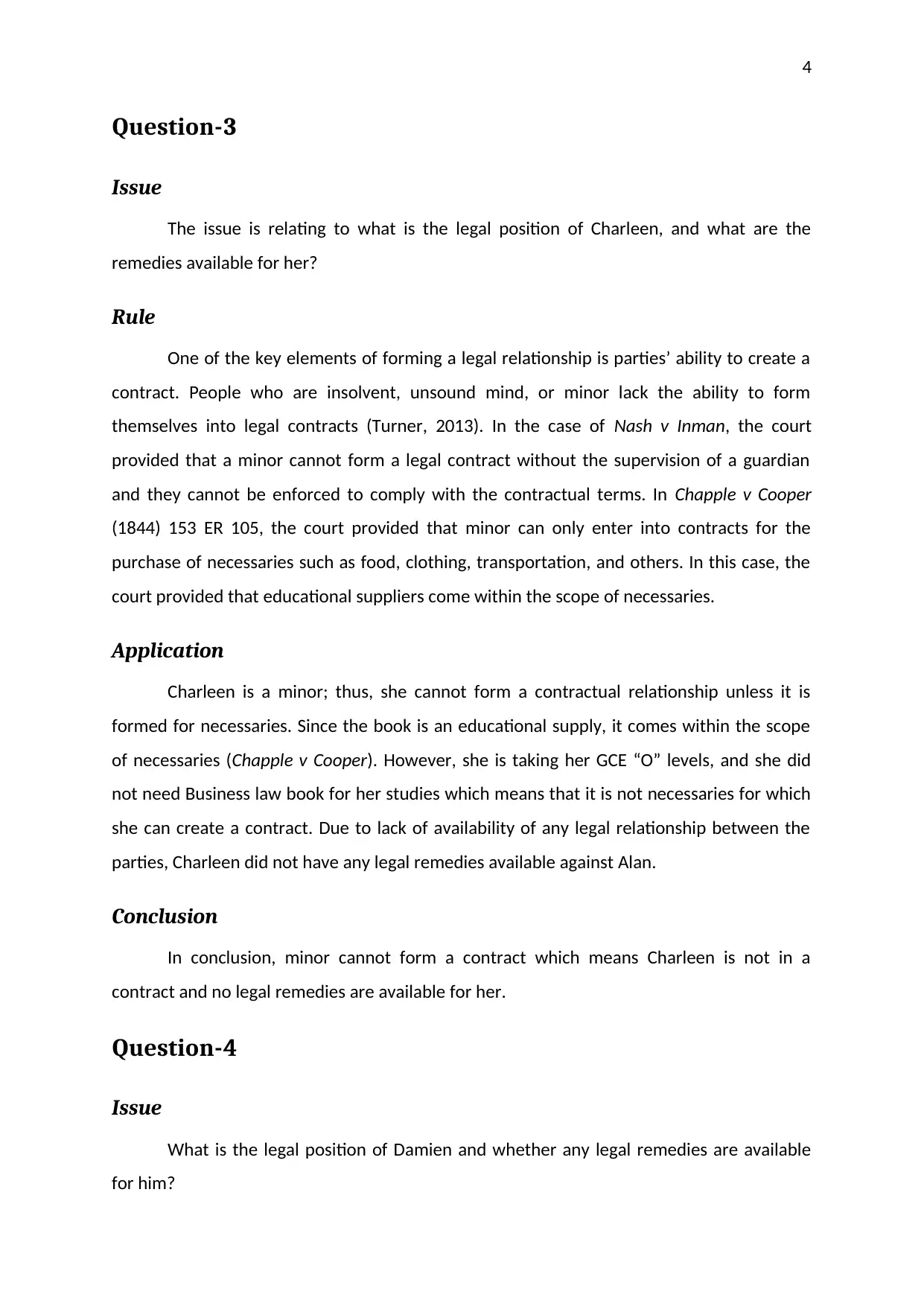
4
Question-3
Issue
The issue is relating to what is the legal position of Charleen, and what are the
remedies available for her?
Rule
One of the key elements of forming a legal relationship is parties’ ability to create a
contract. People who are insolvent, unsound mind, or minor lack the ability to form
themselves into legal contracts (Turner, 2013). In the case of Nash v Inman, the court
provided that a minor cannot form a legal contract without the supervision of a guardian
and they cannot be enforced to comply with the contractual terms. In Chapple v Cooper
(1844) 153 ER 105, the court provided that minor can only enter into contracts for the
purchase of necessaries such as food, clothing, transportation, and others. In this case, the
court provided that educational suppliers come within the scope of necessaries.
Application
Charleen is a minor; thus, she cannot form a contractual relationship unless it is
formed for necessaries. Since the book is an educational supply, it comes within the scope
of necessaries (Chapple v Cooper). However, she is taking her GCE “O” levels, and she did
not need Business law book for her studies which means that it is not necessaries for which
she can create a contract. Due to lack of availability of any legal relationship between the
parties, Charleen did not have any legal remedies available against Alan.
Conclusion
In conclusion, minor cannot form a contract which means Charleen is not in a
contract and no legal remedies are available for her.
Question-4
Issue
What is the legal position of Damien and whether any legal remedies are available
for him?
Question-3
Issue
The issue is relating to what is the legal position of Charleen, and what are the
remedies available for her?
Rule
One of the key elements of forming a legal relationship is parties’ ability to create a
contract. People who are insolvent, unsound mind, or minor lack the ability to form
themselves into legal contracts (Turner, 2013). In the case of Nash v Inman, the court
provided that a minor cannot form a legal contract without the supervision of a guardian
and they cannot be enforced to comply with the contractual terms. In Chapple v Cooper
(1844) 153 ER 105, the court provided that minor can only enter into contracts for the
purchase of necessaries such as food, clothing, transportation, and others. In this case, the
court provided that educational suppliers come within the scope of necessaries.
Application
Charleen is a minor; thus, she cannot form a contractual relationship unless it is
formed for necessaries. Since the book is an educational supply, it comes within the scope
of necessaries (Chapple v Cooper). However, she is taking her GCE “O” levels, and she did
not need Business law book for her studies which means that it is not necessaries for which
she can create a contract. Due to lack of availability of any legal relationship between the
parties, Charleen did not have any legal remedies available against Alan.
Conclusion
In conclusion, minor cannot form a contract which means Charleen is not in a
contract and no legal remedies are available for her.
Question-4
Issue
What is the legal position of Damien and whether any legal remedies are available
for him?
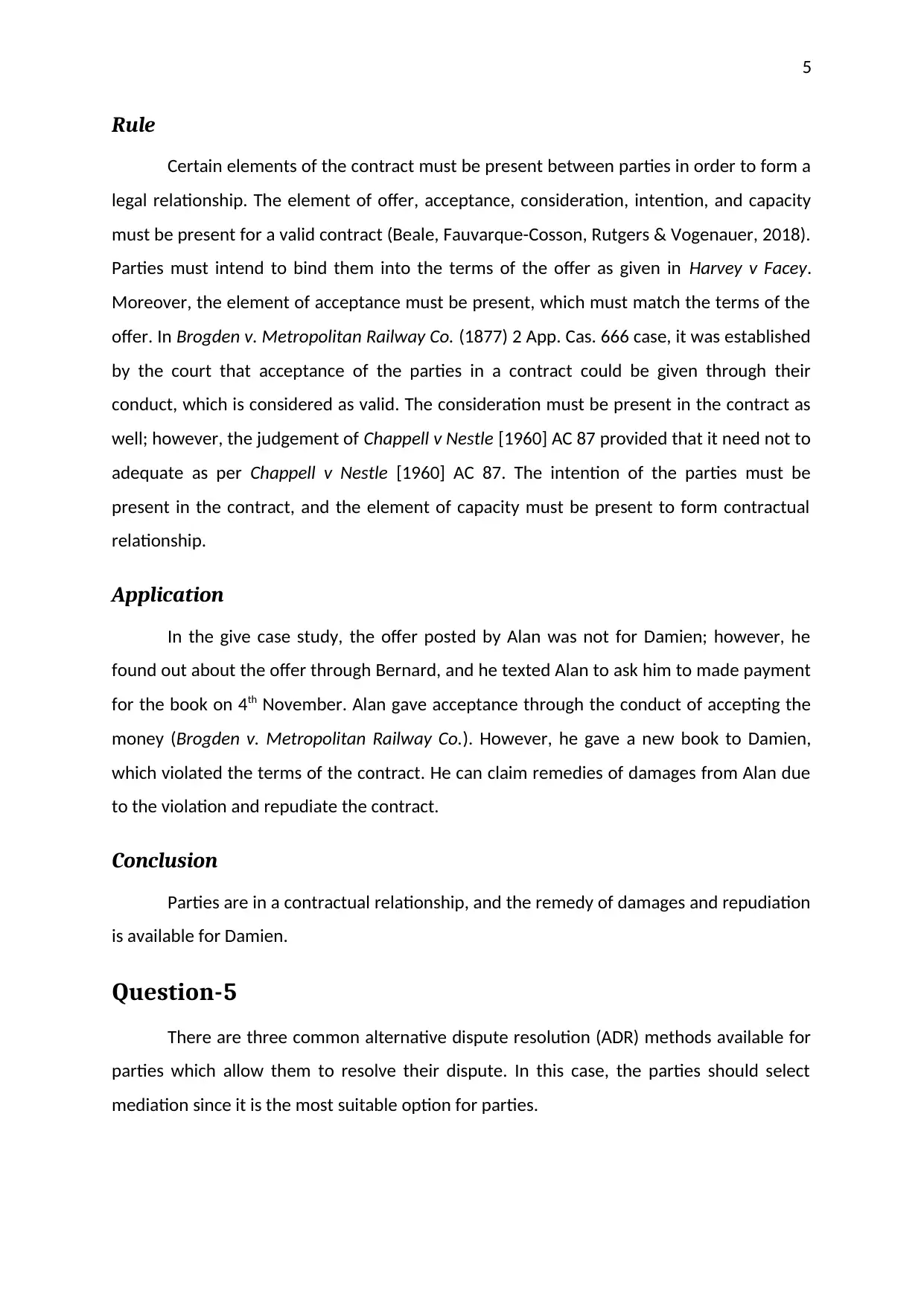
5
Rule
Certain elements of the contract must be present between parties in order to form a
legal relationship. The element of offer, acceptance, consideration, intention, and capacity
must be present for a valid contract (Beale, Fauvarque-Cosson, Rutgers & Vogenauer, 2018).
Parties must intend to bind them into the terms of the offer as given in Harvey v Facey.
Moreover, the element of acceptance must be present, which must match the terms of the
offer. In Brogden v. Metropolitan Railway Co. (1877) 2 App. Cas. 666 case, it was established
by the court that acceptance of the parties in a contract could be given through their
conduct, which is considered as valid. The consideration must be present in the contract as
well; however, the judgement of Chappell v Nestle [1960] AC 87 provided that it need not to
adequate as per Chappell v Nestle [1960] AC 87. The intention of the parties must be
present in the contract, and the element of capacity must be present to form contractual
relationship.
Application
In the give case study, the offer posted by Alan was not for Damien; however, he
found out about the offer through Bernard, and he texted Alan to ask him to made payment
for the book on 4th November. Alan gave acceptance through the conduct of accepting the
money (Brogden v. Metropolitan Railway Co.). However, he gave a new book to Damien,
which violated the terms of the contract. He can claim remedies of damages from Alan due
to the violation and repudiate the contract.
Conclusion
Parties are in a contractual relationship, and the remedy of damages and repudiation
is available for Damien.
Question-5
There are three common alternative dispute resolution (ADR) methods available for
parties which allow them to resolve their dispute. In this case, the parties should select
mediation since it is the most suitable option for parties.
Rule
Certain elements of the contract must be present between parties in order to form a
legal relationship. The element of offer, acceptance, consideration, intention, and capacity
must be present for a valid contract (Beale, Fauvarque-Cosson, Rutgers & Vogenauer, 2018).
Parties must intend to bind them into the terms of the offer as given in Harvey v Facey.
Moreover, the element of acceptance must be present, which must match the terms of the
offer. In Brogden v. Metropolitan Railway Co. (1877) 2 App. Cas. 666 case, it was established
by the court that acceptance of the parties in a contract could be given through their
conduct, which is considered as valid. The consideration must be present in the contract as
well; however, the judgement of Chappell v Nestle [1960] AC 87 provided that it need not to
adequate as per Chappell v Nestle [1960] AC 87. The intention of the parties must be
present in the contract, and the element of capacity must be present to form contractual
relationship.
Application
In the give case study, the offer posted by Alan was not for Damien; however, he
found out about the offer through Bernard, and he texted Alan to ask him to made payment
for the book on 4th November. Alan gave acceptance through the conduct of accepting the
money (Brogden v. Metropolitan Railway Co.). However, he gave a new book to Damien,
which violated the terms of the contract. He can claim remedies of damages from Alan due
to the violation and repudiate the contract.
Conclusion
Parties are in a contractual relationship, and the remedy of damages and repudiation
is available for Damien.
Question-5
There are three common alternative dispute resolution (ADR) methods available for
parties which allow them to resolve their dispute. In this case, the parties should select
mediation since it is the most suitable option for parties.
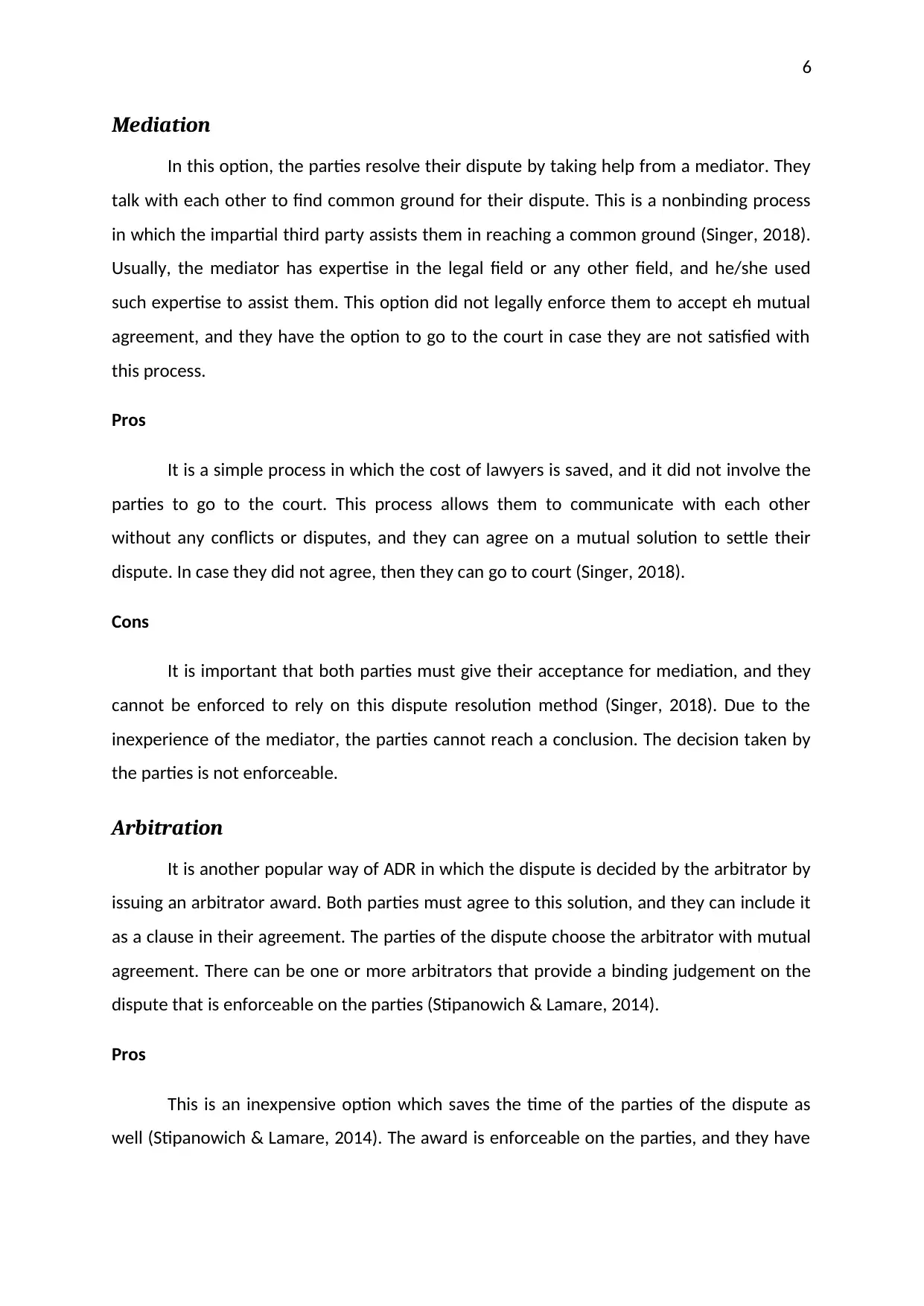
6
Mediation
In this option, the parties resolve their dispute by taking help from a mediator. They
talk with each other to find common ground for their dispute. This is a nonbinding process
in which the impartial third party assists them in reaching a common ground (Singer, 2018).
Usually, the mediator has expertise in the legal field or any other field, and he/she used
such expertise to assist them. This option did not legally enforce them to accept eh mutual
agreement, and they have the option to go to the court in case they are not satisfied with
this process.
Pros
It is a simple process in which the cost of lawyers is saved, and it did not involve the
parties to go to the court. This process allows them to communicate with each other
without any conflicts or disputes, and they can agree on a mutual solution to settle their
dispute. In case they did not agree, then they can go to court (Singer, 2018).
Cons
It is important that both parties must give their acceptance for mediation, and they
cannot be enforced to rely on this dispute resolution method (Singer, 2018). Due to the
inexperience of the mediator, the parties cannot reach a conclusion. The decision taken by
the parties is not enforceable.
Arbitration
It is another popular way of ADR in which the dispute is decided by the arbitrator by
issuing an arbitrator award. Both parties must agree to this solution, and they can include it
as a clause in their agreement. The parties of the dispute choose the arbitrator with mutual
agreement. There can be one or more arbitrators that provide a binding judgement on the
dispute that is enforceable on the parties (Stipanowich & Lamare, 2014).
Pros
This is an inexpensive option which saves the time of the parties of the dispute as
well (Stipanowich & Lamare, 2014). The award is enforceable on the parties, and they have
Mediation
In this option, the parties resolve their dispute by taking help from a mediator. They
talk with each other to find common ground for their dispute. This is a nonbinding process
in which the impartial third party assists them in reaching a common ground (Singer, 2018).
Usually, the mediator has expertise in the legal field or any other field, and he/she used
such expertise to assist them. This option did not legally enforce them to accept eh mutual
agreement, and they have the option to go to the court in case they are not satisfied with
this process.
Pros
It is a simple process in which the cost of lawyers is saved, and it did not involve the
parties to go to the court. This process allows them to communicate with each other
without any conflicts or disputes, and they can agree on a mutual solution to settle their
dispute. In case they did not agree, then they can go to court (Singer, 2018).
Cons
It is important that both parties must give their acceptance for mediation, and they
cannot be enforced to rely on this dispute resolution method (Singer, 2018). Due to the
inexperience of the mediator, the parties cannot reach a conclusion. The decision taken by
the parties is not enforceable.
Arbitration
It is another popular way of ADR in which the dispute is decided by the arbitrator by
issuing an arbitrator award. Both parties must agree to this solution, and they can include it
as a clause in their agreement. The parties of the dispute choose the arbitrator with mutual
agreement. There can be one or more arbitrators that provide a binding judgement on the
dispute that is enforceable on the parties (Stipanowich & Lamare, 2014).
Pros
This is an inexpensive option which saves the time of the parties of the dispute as
well (Stipanowich & Lamare, 2014). The award is enforceable on the parties, and they have
Paraphrase This Document
Need a fresh take? Get an instant paraphrase of this document with our AI Paraphraser
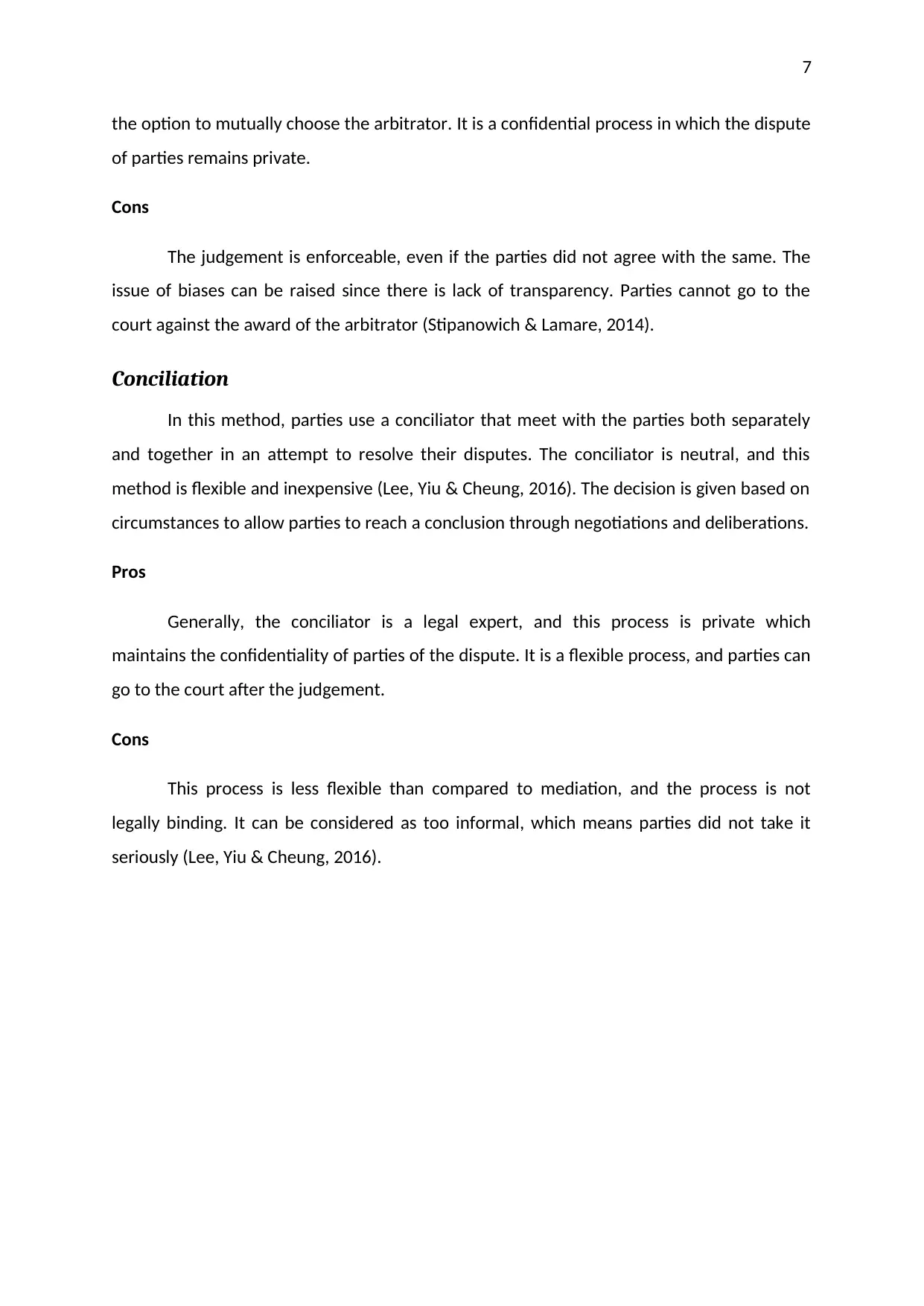
7
the option to mutually choose the arbitrator. It is a confidential process in which the dispute
of parties remains private.
Cons
The judgement is enforceable, even if the parties did not agree with the same. The
issue of biases can be raised since there is lack of transparency. Parties cannot go to the
court against the award of the arbitrator (Stipanowich & Lamare, 2014).
Conciliation
In this method, parties use a conciliator that meet with the parties both separately
and together in an attempt to resolve their disputes. The conciliator is neutral, and this
method is flexible and inexpensive (Lee, Yiu & Cheung, 2016). The decision is given based on
circumstances to allow parties to reach a conclusion through negotiations and deliberations.
Pros
Generally, the conciliator is a legal expert, and this process is private which
maintains the confidentiality of parties of the dispute. It is a flexible process, and parties can
go to the court after the judgement.
Cons
This process is less flexible than compared to mediation, and the process is not
legally binding. It can be considered as too informal, which means parties did not take it
seriously (Lee, Yiu & Cheung, 2016).
the option to mutually choose the arbitrator. It is a confidential process in which the dispute
of parties remains private.
Cons
The judgement is enforceable, even if the parties did not agree with the same. The
issue of biases can be raised since there is lack of transparency. Parties cannot go to the
court against the award of the arbitrator (Stipanowich & Lamare, 2014).
Conciliation
In this method, parties use a conciliator that meet with the parties both separately
and together in an attempt to resolve their disputes. The conciliator is neutral, and this
method is flexible and inexpensive (Lee, Yiu & Cheung, 2016). The decision is given based on
circumstances to allow parties to reach a conclusion through negotiations and deliberations.
Pros
Generally, the conciliator is a legal expert, and this process is private which
maintains the confidentiality of parties of the dispute. It is a flexible process, and parties can
go to the court after the judgement.
Cons
This process is less flexible than compared to mediation, and the process is not
legally binding. It can be considered as too informal, which means parties did not take it
seriously (Lee, Yiu & Cheung, 2016).
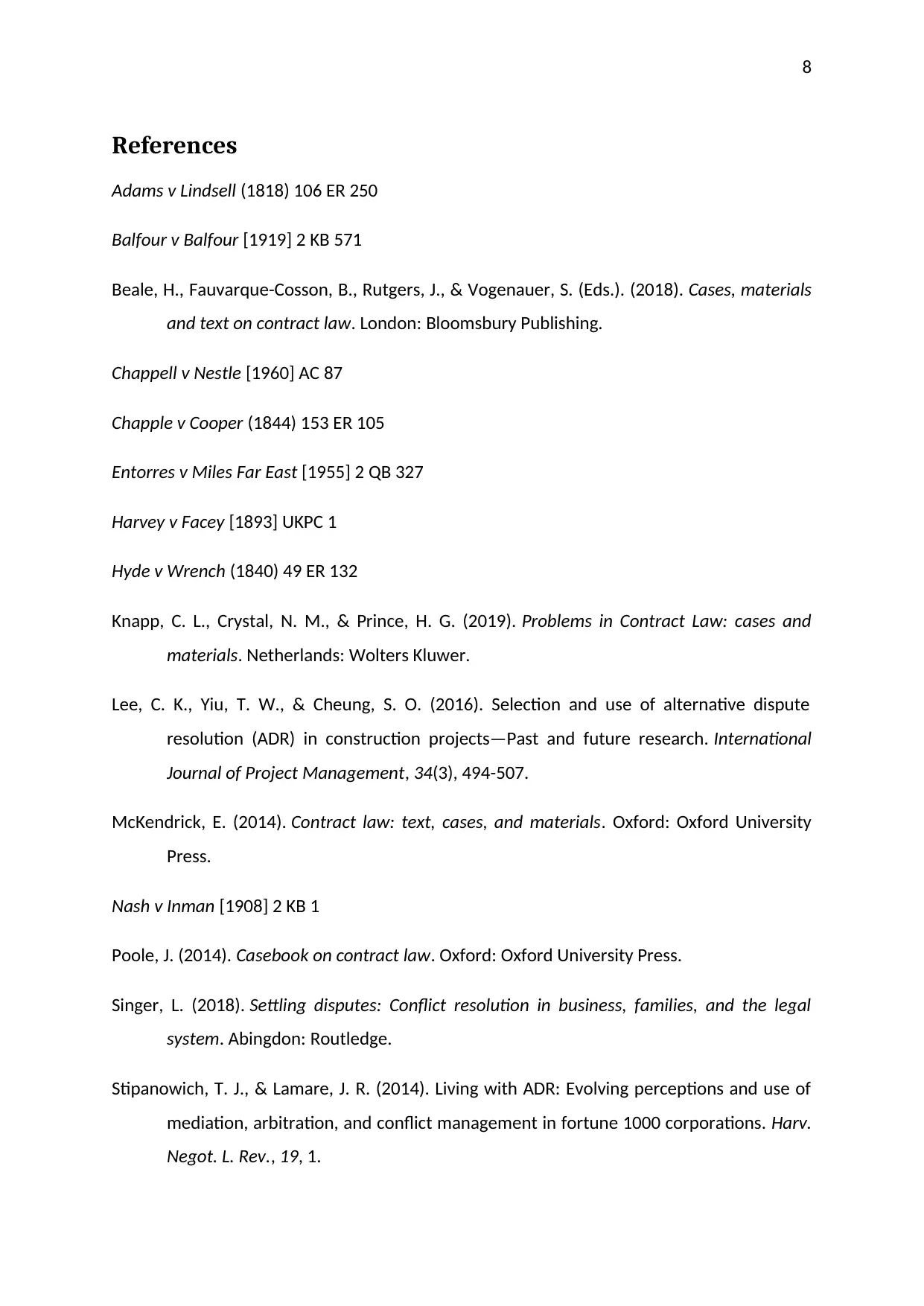
8
References
Adams v Lindsell (1818) 106 ER 250
Balfour v Balfour [1919] 2 KB 571
Beale, H., Fauvarque-Cosson, B., Rutgers, J., & Vogenauer, S. (Eds.). (2018). Cases, materials
and text on contract law. London: Bloomsbury Publishing.
Chappell v Nestle [1960] AC 87
Chapple v Cooper (1844) 153 ER 105
Entorres v Miles Far East [1955] 2 QB 327
Harvey v Facey [1893] UKPC 1
Hyde v Wrench (1840) 49 ER 132
Knapp, C. L., Crystal, N. M., & Prince, H. G. (2019). Problems in Contract Law: cases and
materials. Netherlands: Wolters Kluwer.
Lee, C. K., Yiu, T. W., & Cheung, S. O. (2016). Selection and use of alternative dispute
resolution (ADR) in construction projects—Past and future research. International
Journal of Project Management, 34(3), 494-507.
McKendrick, E. (2014). Contract law: text, cases, and materials. Oxford: Oxford University
Press.
Nash v Inman [1908] 2 KB 1
Poole, J. (2014). Casebook on contract law. Oxford: Oxford University Press.
Singer, L. (2018). Settling disputes: Conflict resolution in business, families, and the legal
system. Abingdon: Routledge.
Stipanowich, T. J., & Lamare, J. R. (2014). Living with ADR: Evolving perceptions and use of
mediation, arbitration, and conflict management in fortune 1000 corporations. Harv.
Negot. L. Rev., 19, 1.
References
Adams v Lindsell (1818) 106 ER 250
Balfour v Balfour [1919] 2 KB 571
Beale, H., Fauvarque-Cosson, B., Rutgers, J., & Vogenauer, S. (Eds.). (2018). Cases, materials
and text on contract law. London: Bloomsbury Publishing.
Chappell v Nestle [1960] AC 87
Chapple v Cooper (1844) 153 ER 105
Entorres v Miles Far East [1955] 2 QB 327
Harvey v Facey [1893] UKPC 1
Hyde v Wrench (1840) 49 ER 132
Knapp, C. L., Crystal, N. M., & Prince, H. G. (2019). Problems in Contract Law: cases and
materials. Netherlands: Wolters Kluwer.
Lee, C. K., Yiu, T. W., & Cheung, S. O. (2016). Selection and use of alternative dispute
resolution (ADR) in construction projects—Past and future research. International
Journal of Project Management, 34(3), 494-507.
McKendrick, E. (2014). Contract law: text, cases, and materials. Oxford: Oxford University
Press.
Nash v Inman [1908] 2 KB 1
Poole, J. (2014). Casebook on contract law. Oxford: Oxford University Press.
Singer, L. (2018). Settling disputes: Conflict resolution in business, families, and the legal
system. Abingdon: Routledge.
Stipanowich, T. J., & Lamare, J. R. (2014). Living with ADR: Evolving perceptions and use of
mediation, arbitration, and conflict management in fortune 1000 corporations. Harv.
Negot. L. Rev., 19, 1.

9
Turner, C. (2013). Contract law. Abingdon: Routledge.
Turner, C. (2013). Contract law. Abingdon: Routledge.
1 out of 10
Your All-in-One AI-Powered Toolkit for Academic Success.
+13062052269
info@desklib.com
Available 24*7 on WhatsApp / Email
![[object Object]](/_next/static/media/star-bottom.7253800d.svg)
Unlock your academic potential
© 2024 | Zucol Services PVT LTD | All rights reserved.



